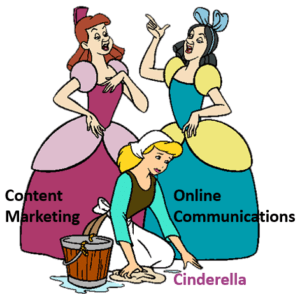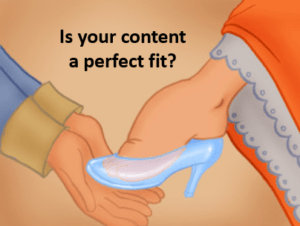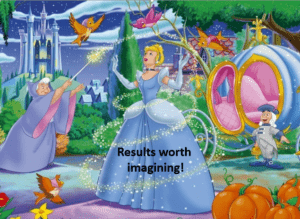 Too often ‘Fundraising’ is made to sit in the corner while her step-sisters, ‘Content Marketing’ and ‘Online Communications’, get busy dressing up for the ball.
Too often ‘Fundraising’ is made to sit in the corner while her step-sisters, ‘Content Marketing’ and ‘Online Communications’, get busy dressing up for the ball.
Poor ‘Fundraising.’
Her step-mother and step-sisters think raising awareness is more important than raising money.
They think all they have to do is look pretty, and they’ll naturally get chosen. Nobody wants to be bothered to include Cinderella (aka Fundraising) in the planning. After all, she’s “dirty.”
Is Fundraising Your Nonprofit’s Dirty Step-Sister?
If this Cinderella story strikes a chord with you, you’re probably working at one of the far too many nonprofits where content marketing, online communications and fundraising are all considered to be step-children. Not a unified, cohesive family. Always bickering. And often undermining one another.
If this is your situation, it’s likely fundraising fares the worst. Fundraising is seen as the support function, rather than an essential, mission-focused one.
Or, even worse, a ‘necessary evil.’
Not sure where your organization stands? Consider how your co-workers and board members might answer the following question:
What’s Marketing’s Most Important Goal: Raising Awareness or Money?
I’ll bet you that many of your colleagues would probably answer “both.”
I’ll also bet you that many will answer “awareness.”
Did you answer that way? Yes?
GO TO JAIL. Go directly to jail. Do not pass GO. Do not collect $200.
Because with that attitude you’re not going to collect much. You’re not going to win.
Your answer to the question “What’s the purpose of our nonprofit marketing strategy?” should be MONEY.
That’s the bottom line.
Creating Awareness is Merely a Pre-Condition to Sales.
I’m being a bit harsh here, I know. But I do so to open your eyes to the truth:
It really doesn’t matter if folks are aware of your existence — if they don’t give two cents whether you continue to exist.
Think about that for a minute.
You probably have some sort of marketing communications program. It probably has a content marketing plan.
- What content you’ll create.
- Who you’ll target to receive it.
- Where and when you’ll deliver it.
But what about the ‘why?’
You’re creating all sorts of materials and distributing them in all sorts of places, offline and online. People are very busy counting all the issues of newsletters, blog posts, social media followers, email opens and so forth.
But are you asking the most important question?
Why are You Creating Awareness Through Marketing?
 What do you want to get out of the fact that folks see/read/listen to this content?
What do you want to get out of the fact that folks see/read/listen to this content?
You’re hoping for an ‘engagement,’ right?
What kind of “match” are you trying to make between the values you enact and the values your would-be donors share?
If you don’t begin here, your content marketing probably won’t work any better than it did for the ugly, clueless step-sisters.
Because they had nothing to offer that the Prince wanted – no matter how they dressed themselves up.
What Does Your Content Marketing Offer Would-Be Donors?
If you don’t ask and answer this question, your marketing communications won’t take you where you need to go.
Because they won’t be a “perfect fit” between values you enact and donors’ active expressions of those values.
Your marketing will just BE. Something you check off your list of tasks:
- We delivered another newsletter.
- Created another annual report.
- Sent out another blog post.
- Made a video.
- Tweeted a link.
- Posted a photo.
And so forth. Blah, blah, blah…
Patting yourself on the back for all these accomplishments?
Wait up.
How Does Your Content and Online Marketing Contribute to Your Fundraising Bottom Line?
 Does the shoe fit?
Does the shoe fit?
Is it something you can use to further your cause?
Or are you just shaping it to fit your own purposes and, essentially, give you bragging rights?
Consider the difference between these outcomes:
- “We got 1,000 new Twitter followers” vs. “We got 1,000 new donations.”
- “50 people shared our story” vs. “50 people with whom the story was shared become new donors.”
- “We showed our video once at our event, and then it sat in our archives’ vs. “We put the video on our website, shared links to it on multiple social channels, and included a donate link at the end.”
Moving forward, I’d like you to Integrate your content marketing with your fundraising.
Bring Cinderella to the Table.
I recently wrote that fundraising and marketing go together like P,B & J. They complement each other brilliantly, and one without the other falls flat.
So, if you work in marketing, don’t miss the opportunity to partner with the fundraisers on your team (and vice-versa) and make your content something that will have universal appeal to your consumers. You want their response to be “yum,” right?
Ask your team partners these five questions about each piece of potential content:
-
What do you want the reader/listener/viewer to feel now?
-
What do you want the reader/listener/viewer to do next?
-
What do you want the reader/listener/viewer to do ultimately (e.g., within a defined timeframe)?
-
How will you get readers to that desired outcome by following up with additional content?
-
How will you assess that this content achieved its objective?
If You’re Investing Resources into Marketing Efforts, You Should be Thinking about Results.
It’s tempting to fall into the trap of preparing and disseminating content designed to do really vague things – “raise awareness,” “engage,” “involve,” and “empower,” for example.
Huh? That and $4 bucks will buy you a beverage at Starbucks.
It’s a bit like asking people to give in order to “restore hope.” What exactly does that mean? And how much does it cost?
Cinderella didn’t ask her Fairy Godmother to give her hope. She asked for something specific — a dress to wear to the ball (plus some overhead, like a coach and coachmen)!
Just as it’s important to be specific with your fundraising asks, it’s important to be specific with your combined fundraising and marketing communications goals.
All of this, to me, is pretty much common sense. But it’s easy to lose sight of common sense. Especially when you’re just following established protocol. And no one seems unhappy with the current modus operandi. And everyone gets into implementation mode, with little time reserved for thinking, planning, collaborating and evaluating.
Make Friends With Your Common Sense!
Don’t do something without a really good reason for doing it.
If someone says “we need a video,” “we need a brochure,” “we need to post more often to Facebook,” “we need a blog,” and so forth, ask “WHY?”
I’m not saying you shouldn’t do these things.
I’m saying: Do content marketing and fundraising with intention.
Establish Bottom-Line Goals and Measure Your Results.
Think about all those terrific, award-winning commercials you watch. They may make you smile, laugh or cry. But do you remember what product they were selling? Sometimes yes. Sometimes they even inspire you to buy the product. But, more often, you can’t even remember what that “great” ad was selling. That means the advertising didn’t work.
Build a content marketing plan this year that works for you.
Consider what types of actions will get you closer to your goals:
- What will raise money so you can continue to fight the good fight?
- What will enlist new recruits to your army of supporters?
- What will grab you the type of attention you need to survive and thrive?
- What will get people to care?
- What will get people to share?
The Fastest Route to Effective Fundraising isn’t Raising Awareness.
It’s getting folks to feel something on an emotional level.
Something that hits them in the gut and grabs them in the heart.
Something that provokes their giving spirit.
Just getting people to know about something is a pretty passive, and ultimately useless, act.
We soothe ourselves with this platitude: “Awareness is the first step to future involvement and investment.”
Platitudes be ding-danged! Yes, it’s partially true. But awareness that doesn’t lead to anything further can be like a lead balloon. A big “so what?”
Unless… you get ahead of the game.
Don’t do anything that’s only a first step.
Figure Out What Will Get People to Act.
Go for the action you desire.
Time and resources are too limited to squander them on window dressing. Pretty videos and brochures and reports are just that. Pretty.
The step-sisters had pretty gowns. What did it get them? They had no inner beauty.
Focus on what’s inside your donors’ heads and hearts. The triggers that will get them to respond with action.
Adhere to the Pareto Rule of 80:20.
Spend 80% of your time figuring out what content you must deliver to open people up to philanthropy.
What has meaning to your supporters, and might make them want to join more passionately in your cause?
Get together your team and ask: What do we know about our constituents based on:
- How they’ve earmarked their gifts?
- How they’ve responded to surveys?
- Other ways they’ve been engaged with our cause?
- How they’ve been engaged with similar causes?
- Most frequently asked questions of our receptionist?
Then spend 20% of your time wrapping up your relevant content in an appealing package.
I’m not saying the package doesn’t matter. It does. Just don’t squander the lion’s share of your resources on “pretty.”
Nobody Puts Fundraising in a Corner!
Get out from behind! Work together as a team to create content with the power to get folks to take a specific, desired action.
Call for that action!
Guess what will happen as a result?
Folks will respond. They’ll feel good about it too. So good, that they even share what they did with their networks. Why not? It feels good to invest your money to participate in something meaningful and bigger than yourself.
You, together with your donors, made a difference!
And all because you took some time to think and plan before you leapt into the standard, same-old content marketing fray.
Now… pat yourself on the back.
May you and your nonprofit live happily ever after.
If you enjoyed this article, and find Clairification useful, please consider enrolling in Clairification School (if you’ve not already done so). My motto is: If I know it, I want you to know it. But I can’t do it alone. It’s just me here. A one-woman shop (just like many of you). No large corporation underwriting me. I can’t do this without communal support.
This is a gentle push. ‘Tuition’ for a full year is under $2/week — less than the cost of a coffee, smoothie or other beverage of your choice. A small price to pay for being a lot more successful in your career. And that, I hope, is what “clairification” will bring to you.
Thank you so much for all you do to make our world a better place. I’ve got your back. You?











Another masterful article! Thank You, Claire!
Thank YOU for reading and commenting. We all learn from each other. 🙂
Another problem with awareness-raising: The premise is almost always one (or both) of these things:
1. The problem we tackle is incredibly huge!
2. We are a completely awesome organization!
Both of these messages are harmful to philanthropy, making people LESS likely to give. So to the extent that they effectively raise awareness (which, fortunately, they seldom do) — they actually suppress fundraising.
Thanks for the comment Jeff. Agree it’s important to make the problem seem solvable. Otherwise, “drop in the bucket” syndrome kicks in, making would-be donors throw up their hands in despair. And, of course, if your content is all about how awesome YOU are, then why on earth would the donor be needed? !